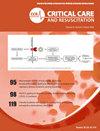危重病人导管中医用粘胶相关皮肤损伤的发生率和危险因素:一项前瞻性队列研究
IF 1.4
4区 医学
Q3 CRITICAL CARE MEDICINE
引用次数: 1
摘要
目的:探讨危重患者导管内医用粘胶性皮肤损伤(MARSI)的发生率及危险因素。方法:在巴西两所大学医院的成人重症监护病房进行前瞻性队列研究。共纳入150例患者(439根导管)。每天由四名训练有素的研究人员检查暴露于导管固定粘合剂(中心静脉,鼻胃,鼻肠和留置尿)的皮肤。从电子病历中收集患者的社会人口学和临床资料。采用双变量统计和多元逻辑回归分析自变量与MARSI之间的关系。结果:MARSI发生率为42%(每100例患者/天8.64例MARSI)。高龄、住院时间延长、皮肤干燥、反复去除粘接剂、布雷登量表评分低和低白蛋白血症与MARSI相关(p < 0.05)。根据多因素logistic回归,皮肤干燥使MARSI的几率增加5.21倍(优势比[OR] 5.21;95%可信区间[95% CI] 2.43-11.11),而布雷登量表评分是一个保护因素,每增加一分,MARSI的可能性降低31% (OR 0.69;95% ci 0.57-0.85)。在鼻肠导管和用天然橡胶粘接剂固定的导管中观察到较高的MARSI发生率。MARSI类型主要为机械性(70.3%):皮肤剥离(41.3%)、皮肤撕裂(26.1%)和张力损伤或水疱(2.9%)。结论:MARSI是成人重症监护病房的常见事件,大多数危险因素是可以改变的。预防行动有可能降低发病率、优化财政资源和改善临床结果。本文章由计算机程序翻译,如有差异,请以英文原文为准。
Incidence and risk factors for medical adhesive-related skin injury in catheters of critically ill patients: A prospective cohort study
Aim: To investigate the incidence and risk factors for medical adhesive-related skin injury (MARSI) in catheters of critically ill patients. Methods: A prospective cohort study was conducted in adult intensive care units of two Brazilian university hospitals. A total of 150 patients (439 catheters) were included. Skin exposed to the catheter fixation adhesives (central venous, nasogastric, nasoenteral and indwelling urinary) was examined daily by four trained researchers. The patients sociodemographic and clinical data were collected from their electronic medical records. The association between independent variables and MARSI was investigated by bivariate statistics, followed by multiple logistic regression. Results: The MARSI incidence was 42% (8.64 MARSIs per 100 patients/day). Advanced age, prolonged hospital stay, dry skin, repetitive adhesive removal, low Braden Scale score and hypoalbuminemia were associated with MARSI (p < .05). According to multivariate logistic regression, dry skin increased the chance of MARSI by 5.21 times (odds ratio [OR] 5.21; 95% confidence interval [95% CI] 2.43-11.11), while the Braden Scale score was a protective factor, showing 31% less chance of MARSI for each added score (OR 0.69; 95% CI 0.57-0.85). A higher incidence of MARSI was observed in nasoenteral catheters and in those fixed with adhesive using natural rubber. The MARSI types were predominantly mechanical (70.3%): skin stripping (41.3%), skin tear (26.1%) and tension injury or blister (2.9%). Conclusions: MARSI is a common event in adult intensive care units and most risk factors are modifiable. Preventive actions are potentially capable of reducing incidence, optimizing financial resources and improving clinical results.
求助全文
通过发布文献求助,成功后即可免费获取论文全文。
去求助
来源期刊

Critical Care and Resuscitation
CRITICAL CARE MEDICINE-
CiteScore
7.70
自引率
3.40%
发文量
44
审稿时长
>12 weeks
期刊介绍:
ritical Care and Resuscitation (CC&R) is the official scientific journal of the College of Intensive Care Medicine (CICM). The Journal is a quarterly publication (ISSN 1441-2772) with original articles of scientific and clinical interest in the specialities of Critical Care, Intensive Care, Anaesthesia, Emergency Medicine and related disciplines.
The Journal is received by all Fellows and trainees, along with an increasing number of subscribers from around the world.
The CC&R Journal currently has an impact factor of 3.3, placing it in 8th position in world critical care journals and in first position in the world outside the USA and Europe.
 求助内容:
求助内容: 应助结果提醒方式:
应助结果提醒方式:


